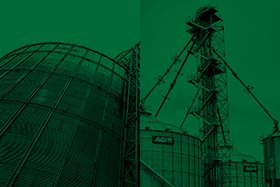Configuring an AGI En-Masse Conveyor:
The following steps outline the process of configuring an appropriate AGI conveyor for your application. These steps are intended as a guide only. We strongly advise contacting AGI to review your application and obtain the appropriate recommendations for your specific needs.
- Material type handled
- Power requirements vary for different grains
- The method of feeding the conveyor: The conveyor can be flood-fed where the capacity of the conveyor is determined by the speed of the chain. The conveyor can be control-fed by a bucket elevator, for example. The conveyor capacity is affected by how it is fed.
- The required system capacity in bushels per hour or metric tons per hour
- The length between the input and output of the conveyor
- Review the model specifications in the En-Masse Conveyor section of the current AGI sales manual to choose a standard model based on the desired capacity
- Determine any desired options
- Use the tables in the current AGI sales manual to determine horsepower and bearing diameter requirements as well as maximum acceptable conveyor lengths.
- Use the diagrams and tables in the current AGI sales manual for verification
If you have questions, please contact us. One of our experienced sales staff or engineers will work with you to ensure that you specify the right en-masse conveyor for your situation.








